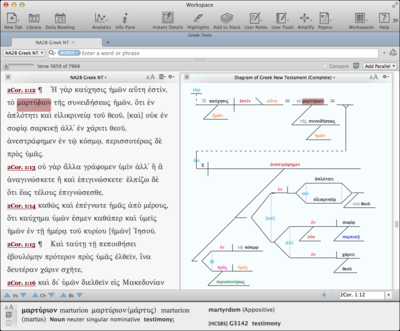Remember diagramming sentences in school? If you’re under forty, you might not, but I have vivid memories of diagramming sentences in high school English. At the time it seemed like a pointless exercise, but years later, I came to see its usefulness, especially when it comes to exegeting complex Greek sentences. The Reed-Kellogg system of diagramming is among the oldest and best known. It emphasizes the logical relationships among words and phrases in a sentence, enabling you to see through the peripheral information to the key points being made.
Accordance was the first Bible program to offer diagramming, all the way back in version 3.0. By selecting some text and choosing Diagram from the Language tools (previously on the Resource palette but now on the Workspace toolbar), you could then move the text around and diagram it using a variety of symbols. This was great, but you had to do all the diagramming yourself. Eventually some enterprising users began sharing their diagrams, but we never had anything systematic or complete.
That all changed last week when we released our new Greek Diagrams module. The same scholar responsible for most of our grammatically-tagged Greek texts has carefully diagrammed all the Pauline epistles and will eventually complete the rest of the New Testament. Greek Diagrams is just $59.99, and as with all such work-in-progress resources, when you buy it now you get free upgrades until it is complete.
The Greek Diagrams tool can be displayed in parallel with the Greek text, making it easy to see its logical structure. If you’re learning to diagram on your own, you can use it as a basis of comparison with your own work. The Greek words are color-coded according to part of speech, and if you hover over them in the diagram pane you get the full parsing and gloss information.
Greek Diagrams is available now for purchase and easy install. Also, don’t forget that today is the last day to take advantage of our Black Friday/Cyber Monday sale.


